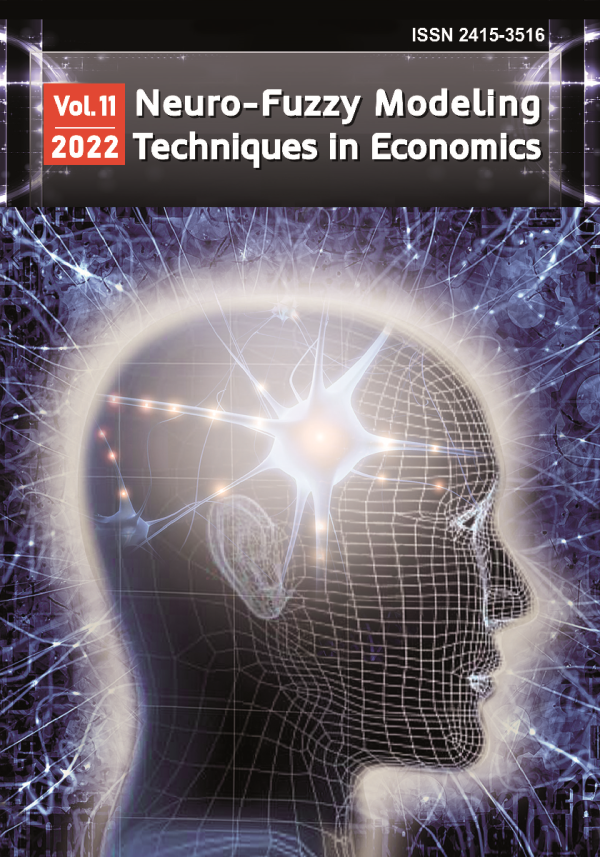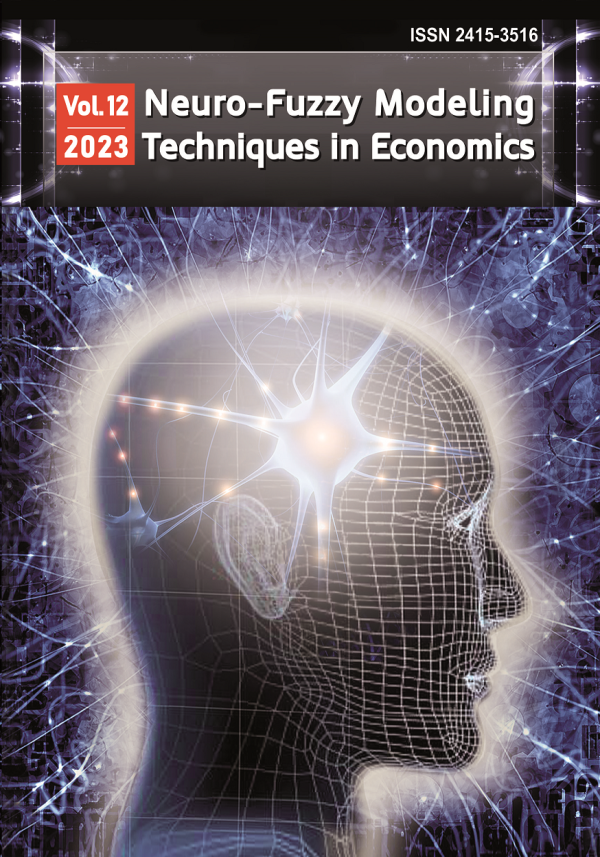
Neuro-Fuzzy Modeling Techniques in Economics
ISSN 2415-3516
Artificial intelligence tools for managing the behavior of economic agents at micro level
DOI:
10.33111/nfmte.2023.003
Анотація:
Abstract: In modern business conditions, effective management of employee behavior is becoming a critical factor in ensuring competitive advantages and development of enterprises. AI tools, which are rapidly developing, provide new opportunities for managing the behavior of economic agents at the micro level and increasing the productivity of companies. To make the most effective use of AI in the outlined processes, there is a need to conduct research into the areas and possibilities of their application and impact on enterprise personnel.
The methodology and mathematical model developed in the article, based on the use of theories of fuzzy sets, neural networks and Lefebvre reflexive control, allow to study the potential and prospects for using AI tools (on an example of SAP SuccessFactors) in managing the behavior of economic agents at the micro level, in particular in predicting the efficiency of employees at enterprise.
It was concluded that the SAP SuccessFactors can evaluate the effectiveness of various personnel groups differently. This may occur due to insufficient adaptation of the models to the specifics of work and personal characteristics of employees of different productivity levels. Therefore, when using AI tools in the management of personnel behavior, it is important to consider such features and make individual settings for different groups of employee performance. This is a key aspect to avoid wrong management decisions that can affect the economic efficiency of the enterprise.
Ключові слова:
Key words: artificial intelligence, reflexive choice function, employee behavior, managing the behavior, economic agent, micro level
УДК:
UDC:
JEL: C02 C45 C81 D01 D03
To cite paper
In APA style
Turlakova, S., & Lohvinenko, B. (2023). Artificial intelligence tools for managing the behavior of economic agents at micro level. Neuro-Fuzzy Modeling Techniques in Economics, 12, 3-39. http://doi.org/10.33111/nfmte.2023.003
In MON style
Турлакова С., Логвіненко Б. Artificial intelligence tools for managing the behavior of economic agents at micro level. Нейро-нечіткі технології моделювання в економіці. 2023. № 12. С. 3-39. http://doi.org/10.33111/nfmte.2023.003 (дата звернення: 14.12.2025).
With transliteration
Turlakova, S., Lohvinenko, B. (2023) Artificial intelligence tools for managing the behavior of economic agents at micro level. Neuro-Fuzzy Modeling Techniques in Economics, no. 12. pp. 3-39. http://doi.org/10.33111/nfmte.2023.003 (accessed 14 Dec 2025).
 # 12 / 2023
# 12 / 2023
Download Paper

1294
Views
235
Downloads
6
Cited by
- Vishnevsky, V., Viyetska, O., Viyetskyi, O., Vorgach, O., Harkushenko, O., Dasiv, A., Zanizdra, M., Zbarazhskaya, L., Kniaziev, S., Kravchenko, S., Lipnytsky, D., Madih, A., Mazur, Y., Nikiforova, V., Okhten, O., Sokolovskaya, O., Turlakova, S., Chekina, V., Shevtsova, G., & Shchetilova, T. (2019). Smart-promyslovist: napriamy stanovlennia, problemy i rishennia [Smart industry: Directions of development, problems and solutions]. National Academy of Sciences of Ukraine, Institute of Industrial Economics. https://iie.org.ua/wp-content/uploads/2020/04/2019-smart-promyslovist_napriamy-stanovlennia-problemy-i-rishennia_compressed-1.pdf [in Ukrainian]
- Kolot, A., Herasymenko, O., Shevchenko, A., & Ryabokon, I. (2022). Employment in the coordinates of digital economy: current trends and foresight trajectories. Neuro-Fuzzy Modeling Techniques in Economics, 11, 78-123. http://doi.org/10.33111/nfmte.2022.078
- Zuboff, S. (2019). Age of surveillance capitalism: The fight for a human future at the new frontier of power. PublicAffairs.
- Logvinenko, B. (2022). Doslidzhennia instrumentiv shtuchnoho intelektu v upravlinni povedinkoiu ekonomichnykh ahentiv u tsyfrovomu prostori na pidpryiemstvakh [Study of artificial intelligence tools in the management of the behavior of economic agents in the digital space at enterprises]. The Journal of V. N. Karazin Kharkiv National University. Series: International Relations. Economics. Country Studies. Tourism, 15, 45-53. https://doi.org/10.26565/2310-9513-2022-15-05 [in Ukrainian]
- Haan, K. (2023). How Businesses Are Using Artificial Intelligence In 2024. Forbes Advisor. https://www.forbes.com/advisor/business/software/ai-in-business/
- Lohvinenko, B. (2022). Upravlinnia povedinkoiu ekonomichnykh ahentiv na pidpryiemstvakh iz vykorystanniam instrumentiv shtuchnoho intelektu [Managing the Behavior of Economic Agents at Enterprises with Artificial Intelligence Tools]. Ekonomika Promyshlennosti (Economy of Industry), 4(100), 78-92. http://doi.org/10.15407/econindustry2022.04.078 [in Ukrainian]
- Traynor, S., Wellens, M. A., & Krishnamoorthy, V. (2021). An Introduction to SAP SuccessFactors Talent Modules. In SAP SuccessFactors Talent: Vol. 1 (pp. 1–6). Apress. https://doi.org/10.1007/978-1-4842-6600-7_1
- Gartner. (2022). SAP SuccessFactors HXM Suite Enterprise IT Software Reviews. Gartner Peer Insights. https://www.gartner.com/reviews/market/cloud-hcm-suites-for-1000-employees/vendor/sap/product/sap-successfactors-hxm-suite/reviews?marketSeoName=cloud-hcm-suites-for-1000-employees&vendorSeoName=sap&productSeoName=sap-successfactors-hxm-suite
- Zuboff, S. (2015). Big other: Surveillance Capitalism and the Prospects of an Information Civilization. Journal of Information Technology, 30(1), 75–89. https://doi.org/10.1057/jit.2015.5
- Crawford, K. (2022). Atlas of AI: Power, Politics, and the Planetary Costs of Artificial Intelligence. Perspectives on Science and Christian Faith, 74(1), 61–62. https://doi.org/10.56315/pscf3-22crawford
- Kidd, C., & Birhane, A. (2023). How AI can distort human beliefs. Science, 380(6651), 1222–1223. https://doi.org/10.1126/science.adi0248
- Yawalkar, V. V. (2019). A study of artificial intelligence and its role in human resource management. International Journal of Research and Analytical Reviews, 6(1), 20–24. https://www.ijrar.org/papers/IJRAR19UP004.pdf
- Cappelli, P., Tambe, P., & Yakubovich, V. (2019). Artificial Intelligence in Human Resources Management: Challenges and a Path Forward. SSRN Electronic Journal. https://doi.org/10.2139/ssrn.3263878
- Ledro, C., Nosella, A., & Dalla Pozza, I. (2023). Integration of AI in CRM: Challenges and Guidelines. Journal of Open Innovation: Technology, Market, and Complexity, 9(4), Article 100151. https://doi.org/10.1016/j.joitmc.2023.100151
- Turlakova, S. (2022). Kontseptualni polozhennia upravlinnia povedinkoiu ekonomichnykh ahentiv u tsyfrovomu prostori z vykorystanniam instrumentiv shtuchnoho intelektu [Conceptual provisions of management of the behavior of economic agents in the digital space using artificial intelligence tools]. Ekonomika ta pidpryiemnytstvo (Economics and Entrepreneurship), 49, 40–54. https://doi.org/10.33111/EE.2022.49.TurlakovaS [in Ukrainian]
- Turlakova, S. (2022). Modeling the values of reflexive characteristics of agents within the management of herd behavior at the enterprises. Neuro-Fuzzy Modeling Techniques in Economics, 11, 48-77. http://doi.org/10.33111/nfmte.2022.048
- Turlakova, S. (2020). Refleksyvnoe upravleniye stadnym povedeniyem na predpriyatyyakh: kontseptsiya, modeli i metody [Reflexive management of herd behavior at enterprises: concept, models and methods]. National Academy of Sciences of Ukraine, Institute of Industrial Economics. https://iie.org.ua/wp-content/uploads/2020/04/mono_turlakova_2020_compressed.pdf [in Russian]
- Zadeh, L.A. (2008). Is there a need for fuzzy logic? Information Sciences, 178(13), 2751-2779. https://doi.org/10.1016/j.ins.2008.02.012
- Romanos, G. D. (1973). Reflexive Predictions. Philosophy of Science, 40(1), 97–109. https://doi.org/10.1086/288499
- McClelland, D. С. (2001). Chapter 27: Where Do We Stand on Assessing Competencies? Counterpoints, 166, 479–489. http://www.jstor.org/stable/42977810
- Spencer, L. M., & Spencer, S. M. (2008). Competence at Work: Models for Superior Performance. John Wiley & Sons.
- Robert, K., & Ola, L. (2021). Reflexive sensegiving: An open-ended process of influencing the sensemaking of others during organizational change. European Management Journal, 39(4), 476–486. https://doi.org/10.1016/j.emj.2020.10.007
- Jamieson, M. K., Govaart, G. H., & Pownall, M. (2023). Reflexivity in quantitative research: A rationale and beginner’s guide. Social and Personality Psychology Compass, 17(4), Article e12735. https://doi.org/10.1111/spc3.12735
- Burk, D. (2020). Algorithmic legal metrics. AoIR Selected Papers of Internet Research, 2020. https://doi.org/10.5210/spir.v2020i0.11184
- Kohonen, T. (2001). Self-Organizing Maps. Springer-Verlag.
- Lefebvre, V. (2001). Algebra of conscience. Springer Science & Business Media.
- Lefebvre, V. A. (2017). Bipolar Choice in Experimental Chamber. Bipolar Disorder, 3(1). Article 115. https://doi.org/10.4172/2472-1077.1000115

